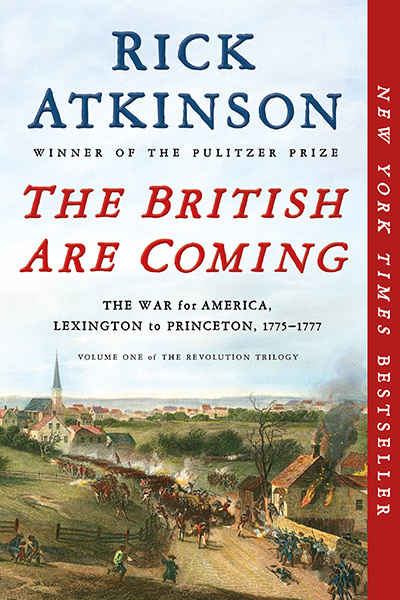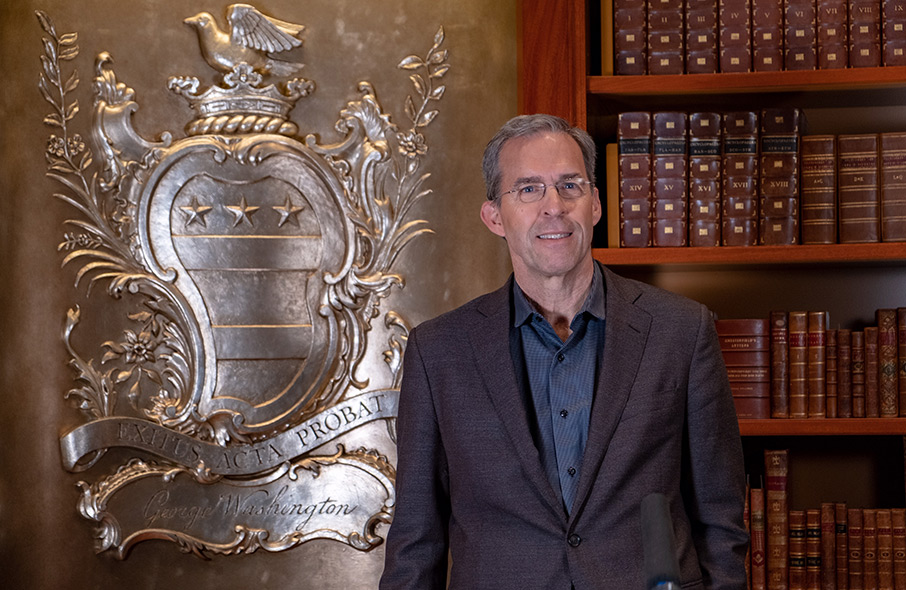Excerpt
[From The British Are Coming, pgs 348-350]
The fateful news traveled swiftly on the post road from Philadelphia, covering more than ninety miles and crossing five rivers in just a couple of days. Precise copies were then made of the thirteen-hundred-word broadside, titled “A Declaration,” that arrived at the Mortier mansion headquarters, and by Tuesday, July 9, General Washington was ready for every soldier in his command to hear what Congress had to say. In his orders that morning, after affirming thirty-nine lashes for two convicted deserters, he instructed the army to assemble at six p.m. on various parade grounds, from Governors Island to King’s Bridge. Each brigade major would then read—“with an audible voice”—the proclamation intended to transform a squalid family brawl into a cause as ambitious and righteous as any in human history.
That evening the commander in chief himself appeared on horseback at the Common with a suite of staff officers, not far from where Sergeant Hickey had tumbled from the scaffold two weeks earlier. Erect and somber, Washington rode into the middle of a hollow square formed by New York and Connecticut regiments while a chirpy throng of civilians ringed the greensward. A uniformed aide spurred his horse forward; the crowd hushed as he unfolded his script and began to read: “In Congress, July 4, 1776.” Even the most unlettered private recognized that something majestic was in the air.
We hold these truths to be self-evident, that all men are created equal, that they are endowed by their Creator with certain unalienable rights, that among these are life, liberty, and the pursuit of happiness. That to secure these rights, governments are instituted among men, deriving their just powers from the consent of the governed.
On and on it went, describing the “long train of abuses and usurpations,” then denouncing royal despotism, then enumerating twenty-seven grievances. Those shifting from foot to foot as the reader droned through a condemnation of “our British brethren” would have been relieved to know that Congress had pruned the original draft by a quarter for the sake of concision and restraint. The primary author—a lanky, ginger-haired Virginia planter named Thomas Jefferson—was widely acknowledged even at age thirty-three to have “a happy talent of composition,” as John Adams conceded. Perched in a swiveling Windsor chair on the second floor of rented rooms at Seventh and High Streets in Philadelphia, a compact, custom-built writing desk in his lap, Jefferson had sought, as he later explained, “to place before mankind the common sense of the subject, in terms so plain and firm as to command their assent. . . . It was intended to be an expression of the American mind.”
Just so, despite what he considered the “mutilations” imposed by his congressional colleagues, sitting at tables covered in green baize in the Pennsylvania State House, lashing at horseflies with their handkerchiefs while scratching up his draft with their quills. The leaner, edited result remained a stirring manifesto of republicanism, a radical assertion that power derived not from God or through bloodlines but from the people, and should benefit the many, not just the affluent or well-born. Of the ninety or more declarations and petitions drafted by the colonies in recent months, as counted by the historian Pauline Maier, none surpassed this document in elegance, clarity, or breathtaking vision. That at least a third of the delegates who would sign the Declaration were slave owners—Jefferson alone had two hundred—was a moral catastrophe that could never be reconciled with the avowed principles of equality and “unalienable rights,” at least not in the eighteenth century. But as Edmund S. Morgan would write, “The creed of equality did not give men equality, but invited them to claim it, invited them, not to know their place and keep it, but to seek and demand a better place.”
The reader finished his oration, a bit hoarse now, by proclaiming all political ties with Britain “to be totally dissolved” and the colonies to be “free and independent states.” To this declaration the disputatious men in Philadelphia had pledged “our lives, our fortunes, and our sacred honor.” A chaplain recited Psalm 80—“Turn us again, O God of hosts, and cause thy face to shine, and we shall be saved.” Loud cheers washed over the Common, and Thomas Mifflin, the adjutant general, reportedly climbed onto a cannon and shouted, “My lads, the Rubicon is crossed!”
Washington trotted back to his headquarters, but the rambunctious crowd meandered south on Broadway. Here George III, identified that very evening in the Declaration as a tyrant “unfit to be the ruler of a free people,” sat atop his gilt horse on Bowling Green. Whooping vandals broke through the iron fence surrounding the statue, clambered onto the marble pedestal, and lassoed the equestrian figure. Scores of soldiers and civilians tugged on the ropes until the two-ton statue capsized with a tremendous crash—“leveled with ye dust,” a witness reported. The baying crowd decapitated the king, whacked off his nose, and clipped the laurels from his brow. Someone fired a musket ball into the head, and more balls punctured the torso. Others scraped away the ten ounces of gold leaf that covered rider and mount. With fife and drums playing “The Rogue’s March,” the severed head was first wheeled in a barrow to the Mortier house, then impaled on a spike outside the Blue Bell Tavern. To one spectator the scene evoked the fallen angel Lucifer, as described by poet John Milton: “O, how fallen! How changed!”
The head would be recovered by British Army engineer John Montresor and shipped to England to further illustrate the “disposition of the ungrateful people.” The headless rider and horse were carted in fragments to a Connecticut foundry, where patriot women melted the lead, ladled it into molds, and soon sent the army 42,088 bullets. “It is hoped,” the surgeon Isaac Bangs told his journal, “that the emanations of the leaden George will make as deep impressions in the bodies of some of his red-coated and Tory subjects.”
Exuberant demonstrations erupted throughout the thirteen new states as word of the Declaration spread. Salutes and toasts followed publication of the document in the same issue of the Virginia Gazette that listed bounties for runaway slaves. Savannah held a sham burial of King George, accompanied by muffled drums. Other towns staged mock trials and executions. A Long Island village fashioned an effigy of the king with a wooden crown and feathers, wrapped it in a Union Jack packed with gunpowder, then blew it up on a gallows. In Dover, Delaware, rebels tossed George’s portrait into a bonfire. “Thus,” they announced, “we destroy even the shadow of that king who refused to reign over a free people.” In New Hampshire, mobs smashed tavern signs depicting a crown or the king’s arms; some merchants refused coins with the king’s likeness. Other protesters settled for turning the monarch’s image to the wall or hanging it upside down. Delaware troops marched from Wilmington to New Castle, tearing down the royal coat of arms and other “baubles of royalty,” which were then stacked before the courthouse and burned to ash. Abigail Adams wrote John of listening as the Declaration was read from a balcony in Boston. Cheers rent the welkin, she reported. Bells rang, shore batteries boomed, and soldiers fired by platoons in celebration. “Every face appeared joyful,” she wrote. “Thus ends the royal authority in this state, and all the people shall say amen.”
An excerpt from The British Are Coming: The War for America, Lexington to Princeton, 1775–1777, copyright Rick Atkinson 2019











